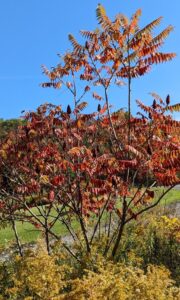Forest Fridays: Sumac – Invasive or Poisonous? – Technologist
Author: Chris Firestone
NEITHER!

Female staghorn sumac in fall color, notice the red berry clusters at the terminal end of the plant.
In Pennsylvania there are four species of sumac in the Rhus genus and Anacardiaceae (Cashew) family. The four species are native, not poisonous, and not invasive. Perhaps the most common and well-known species of sumac in Pennsylvania is staghorn sumac (Rhus typhina), whose stems are covered with dense, short, and stout hairs resembling deer antlers in velvet. Like other sumacs, it is dioecious; the male flowers are very attractive to pollinators but do not persist through the growing season; however the red, hairy berry clusters of the female plants stand out the entire year. I have observed migrating robins eating these berries in a March snow squall. This time of year, the brilliant red of the staghorn sumac leaves along the roadways add to the fall color.
Staghorn sumac has been called invasive, especially when seen in dense colonies formed by its clonal habit. Additionally, its appearance and similar features to the common and invasive tree-of-heaven (Ailanthus altissima) may erroneously give someone the idea that staghorn sumac is invasive. Both species have compound leaves, but the margins of the leaflets are toothed, entire, and smooth in staghorn sumac, with one tooth on either side at the base of the leaflet helping to differentiate tree-of-heaven. Staghorn sumac does not emit the distinctive odor found when crushing leaves of tree-of-heaven. Another difference is that the fruit of staghorn sumac can be used to make a delicious and refreshing drink. I don’t want to try that with tree-of-heaven fruit!

Staghorn sumac leaf with toothed margin on the leaflets. The rachis is covered in dense hairs.

Tree of heaven leaflets on a leaf, notice the enlarged tooth at the base of the leaflet.
Other native sumac species contributing to Pennsylvania’s flora include fragrant sumac (Rhus aromatica), eastern winged sumac (Rhus copallinum) and smooth sumac (Rhus glabra). All can be found growing in dry woodlands and clearings and are common except for fragrant sumac.
I can almost hear the reader thinking, “What about poison sumac?”. It most certainly grows in Pennsylvania and can cause skin irritation from the resin, urushiol, just like poison ivy (Toxicodendron radicans), if the oils get on your skin. However, poison sumac (Toxicodendron vernix) is more closely related to poison ivy than the other four species of sumac and is sumac by name only. Poison ivy and poison sumac are in the same family as the sumacs (Anacardiaceae). Poison sumac is a multi-stemmed shrub or small tree that grows 99 percent of the time in peatmoss-dominated wetlands. One is unlikely to encounter poison sumac out exploring Penns Woods on dry land.

Poison sumac leaves and immature fruit, which are white when mature.
Forest Fridays is a project of the Pennsylvania Department of Conservation and Natural Resources, Bureau of Forestry. Content and photos shared courtesy of the author.


